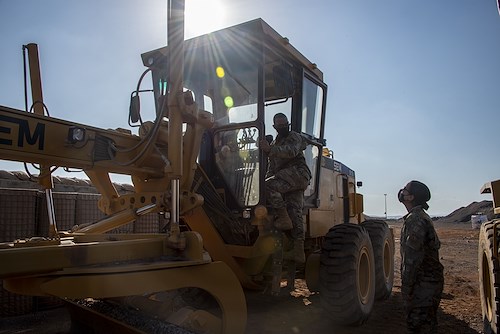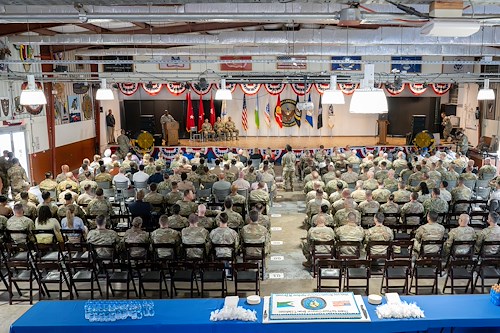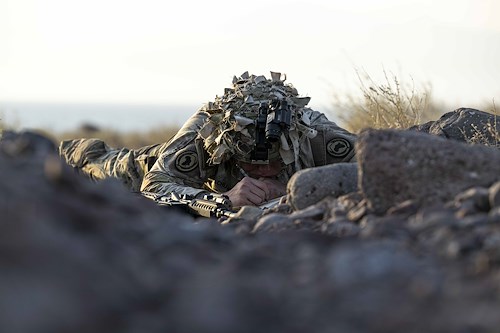Gallery contains 4 images
×
Photo 1 of 4
CADJ dream team keeps planes in the sky
U.S. Air Force Staff Sgt. Darius Etheridge, operations management, 776th Expeditionary Air Base Squadron (EABS), talks with U.S. Air Force 1st Lt. LeighAnn D’Andrea, base civil engineer, 776th EABS, Jan. 8, 2021, at Chabelley Airfield, Djibouti. Etheridge says his successes stem from D’Andrea’s leadership style. She empowered and encouraged him by trusting him to make the right decisions. (U.S. Air Force photo by Senior Airman Kristin Savage)
Photo by: Senior Airman Kristin Savage
Photo 2 of 4
CADJ dream team keeps planes in the sky
U.S. Air Force Staff Sgt. Darius Etheridge, operations management, 776th Expeditionary Air Base Squadron (EABS), and U.S. Air Force 1st Lt. LeighAnn D’Andrea, base civil engineer, 776th EABS, pose for a photo, Jan. 8, 2021, at Chabelley Airfeild, Djibouti. D’Andrea and Etheridge have learned the importance of accountability and to take pride in even the smallest things because everything has an impact on the overall mission. (U.S. Air Force photo by Senior Airman Kristin Savage)
Photo by: Senior Airman Kristin Savage
Photo 3 of 4
CADJ dream team keeps planes in the sky
U.S. Air Force 1st Lt. LeighAnn D’Andrea, base civil engineer, 776th Expeditionary Air Base Squadron (EABS), and U.S. Air Force Staff Sgt. Darius Etheridge, operations management, 776th EABS, evaluate various civil engineering projects, Jan. 8, 2021, at Chabelley Airfield, Djibouti. The civil engineer element’s mission is to assess the base operating support contract that keeps the base running for the 12th Expeditionary Special Operations Squadron (ESOS). (U.S. Air Force photo by Senior Airman Kristin Savage)
Photo by: Senior Airman Kristin Savage
Photo 4 of 4
CADJ dream team keeps planes in the sky
U.S. Air Force Staff Sgt. Darius Etheridge, operations management, 776th Expeditionary Air Base Squadron (EABS), and U.S. Air Force 1st Lt. LeighAnn D’Andrea, base civil engineer, 776th EABS, pose for a photo, Jan. 8, 2021, at Chabelley Airfeild, Djibouti. Despite the challenges being geographically separated from their supporting organizations have brought them, they have managed to get the mission done. (U.S. Air Force photo by Senior Airman Kristin Savage)
Photo by: Senior Airman Kristin Savage
Deployments come with challenges no matter what the location or career field but the mission still needs to get done. Working through challenges when thousands of miles from home requires effective communication and team work. Two civil engineers from Cannon Air Force Base, New Mexico, have become the dream team of their element, rising to any challenge that comes their way.
U.S. Air Force 1st Lt. LeighAnn D’Andrea, base civil engineer, 776th Expeditionary Air Base Squadron (EABS), and U.S. Air Force Staff Sgt. Darius Etheridge, operations management, 776th EABS, are the dream team of the civil engineer element by ensuring work tasks are prioritized, communication is streamlined and contracts are being executed properly at Chabelley Airfield, Djibouti (CADJ).
“Our element’s mission here is to assess the base operating support contract that keeps the base running for the 12th Expeditionary Special Operations Squadron (ESOS), the guys that are actually getting the flying mission done,” D’Andrea said. “We assess the contracts and hold the contractor accountable to ensure the base can continue to run.”
D’Andrea and Etheridge have learned the importance of accountability and to take pride in even the smallest things because everything has an impact on the overall mission. Without the civil engineers, the base couldn’t operate and planes couldn’t take off.
“How you do anything, is how you do everything,” D’Andrea said. “For example, there’s a schedule for maintaining air conditioning units, that doesn’t seem important but those units keep the communications systems up and those systems keep the planes in the sky.”
However, their job does not come without challenges. The CADJ CE element is geographically separated from the organizations that support them but modern technology has provided a work around for them.
“I make a lot of phone calls and emails,” D’Andrea said. “Utilizing technology, a little bit of zoom meetings and google meets here and there. It’s learning how to be persistent and getting my team on board so it’s one unified flow of information and not coming from a bunch of different angles.”
Etheridge also needs to find ways to communicate with outside resources. His responsibilities include overseeing assets that support the installation including water, preventative maintenance and lighting.
“How we got to where we are is communication, explaining why a particular item needs to be changed, why properly installed equipment is important and getting on the same page to develop ways to work forward,” Etheridge said. “Things like preventative maintenance help alleviate a lot of the corrective maintenance that could end up happening afterwards, so that’s why it’s important to communicate and hold the contractor accountable.”
Etheridge has a lot to take away from the deployment. After overcoming challenges in communication and coordinating a multitude of projects with just a small element, he has advice for those who come after him.
“The biggest thing I will take back from Chabelley is not give up,” Etheridge said. “There were times that I thought ‘this is a lot for a small element’.”
No matter what the task, the CE element was able to get the job done and the dream team is grateful they had each other to rely on.
“I’m super lucky to have such a dedicated and hard-working ops manager,” D’Andrea said. “Without his work ethic and drive and dedication, we wouldn’t have been as successful as we were.”
Etheridge says his successes stem from D’Andrea’s leadership style. She empowered and encouraged him by trusting him to make the right decisions.
“I’ve had various forms of leadership styles and the one thing I loved the most was having the capability to be a leader in my position and make decisions while keeping her informed,” Etheridge said. “That sense of empowerment was really important to me and when I get a troop someday, I’m going to make sure they feel empowered in whatever they do.”
















